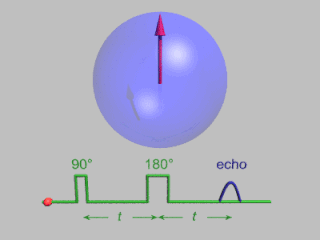
Spectroscopy is the field of study that measures and interprets electromagnetic spectra. In narrower contexts, spectroscopy is the precise study of color as generalized from visible light to all bands of the electromagnetic spectrum.
Dynamic nuclear polarization (DNP) results from transferring spin polarization from electrons to atomic nuclei, thereby aligning the nuclear spins to the extent that electron spins are aligned. Note that the alignment of electron spins at a given magnetic field and temperature is described by the Boltzmann distribution under the thermal equilibrium. It is also possible that those electrons are aligned to a higher degree of order by other preparations of electron spin order such as: chemical reactions, optical pumping and spin injection. DNP is considered one of several techniques for hyperpolarization. DNP can also be induced using unpaired electrons produced by radiation damage in solids.
Microwave spectroscopy is the spectroscopy method that employs microwaves, i.e. electromagnetic radiation at GHz frequencies, for the study of matter.

Electron paramagnetic resonance (EPR) or electron spin resonance (ESR) spectroscopy is a method for studying materials that have unpaired electrons. The basic concepts of EPR are analogous to those of nuclear magnetic resonance (NMR), but the spins excited are those of the electrons instead of the atomic nuclei. EPR spectroscopy is particularly useful for studying metal complexes and organic radicals. EPR was first observed in Kazan State University by Soviet physicist Yevgeny Zavoisky in 1944, and was developed independently at the same time by Brebis Bleaney at the University of Oxford.
Ferromagnetic resonance, or FMR, is coupling between an electromagnetic wave and the magnetization of a medium through which it passes. This coupling induces a significant loss of power of the wave. The power is absorbed by the precessing magnetization of the material and lost as heat. For this coupling to occur, the frequency of the incident wave must be equal to the precession frequency of the magnetization and the polarization of the wave must match the orientation of the magnetization.

Mössbauer spectroscopy is a spectroscopic technique based on the Mössbauer effect. This effect, discovered by Rudolf Mössbauer in 1958, consists of the nearly recoil-free emission and absorption of nuclear gamma rays in solids. The consequent nuclear spectroscopy method is exquisitely sensitive to small changes in the chemical environment of certain nuclei.

In magnetic resonance, a spin echo or Hahn echo is the refocusing of spin magnetisation by a pulse of resonant electromagnetic radiation. Modern nuclear magnetic resonance (NMR) and magnetic resonance imaging (MRI) make use of this effect.

Yevgeny Konstantinovich Zavoisky was a Soviet physicist known for discovery of electron paramagnetic resonance in 1944. He likely observed nuclear magnetic resonance in 1941, well before Felix Bloch and Edward Mills Purcell, but dismissed the results as not reproducible. Zavoisky is also credited with design of luminescence camera for detection of nuclear processes in 1952 and discovery of magneto-acoustic resonance in plasma in 1958.

The nitrogen-vacancy center is one of numerous photoluminescent point defects in diamond. Its most explored and useful properties include its spin-dependent photoluminescence, and its relatively long (millisecond) spin coherence at room temperature. The NV center energy levels are modified by magnetic fields, electric fields, temperature, and strain, which allow it to serve as a sensor of a variety of physical phenomena. Its atomic size and spin properties can form the basis for useful quantum sensors. It has also been explored for applications in quantum computing, quantum simulation, and spintronics.

Nuclear magnetic resonance (NMR) is a physical phenomenon in which nuclei in a strong constant magnetic field are disturbed by a weak oscillating magnetic field and respond by producing an electromagnetic signal with a frequency characteristic of the magnetic field at the nucleus. This process occurs near resonance, when the oscillation frequency matches the intrinsic frequency of the nuclei, which depends on the strength of the static magnetic field, the chemical environment, and the magnetic properties of the isotope involved; in practical applications with static magnetic fields up to ca. 20 tesla, the frequency is similar to VHF and UHF television broadcasts (60–
Electron nuclear double resonance (ENDOR) is a magnetic resonance technique for elucidating the molecular and electronic structure of paramagnetic species. The technique was first introduced to resolve interactions in electron paramagnetic resonance (EPR) spectra. It is currently practiced in a variety of modalities, mainly in the areas of biophysics and heterogeneous catalysis.

Semyon Alexandrovich Altshuler was a Soviet physicist known for his work in resonance spectroscopy and in particular for theoretical prediction of acoustic paramagnetic resonance in 1952.
Magnonics is an emerging field of modern magnetism, which can be considered a sub-field of modern solid state physics. Magnonics combines the study of waves and magnetism. Its main aim is to investigate the behaviour of spin waves in nano-structure elements. In essence, spin waves are a propagating re-ordering of the magnetisation in a material and arise from the precession of magnetic moments. Magnetic moments arise from the orbital and spin moments of the electron, most often it is this spin moment that contributes to the net magnetic moment.

Pulsed electron paramagnetic resonance (EPR) is an electron paramagnetic resonance technique that involves the alignment of the net magnetization vector of the electron spins in a constant magnetic field. This alignment is perturbed by applying a short oscillating field, usually a microwave pulse. One can then measure the emitted microwave signal which is created by the sample magnetization. Fourier transformation of the microwave signal yields an EPR spectrum in the frequency domain. With a vast variety of pulse sequences it is possible to gain extensive knowledge on structural and dynamical properties of paramagnetic compounds. Pulsed EPR techniques such as electron spin echo envelope modulation (ESEEM) or pulsed electron nuclear double resonance (ENDOR) can reveal the interactions of the electron spin with its surrounding nuclear spins.

Paramagnetic nuclear magnetic resonance spectroscopy refers to nuclear magnetic resonance (NMR) spectroscopy of paramagnetic compounds. Although most NMR measurements are conducted on diamagnetic compounds, paramagnetic samples are also amenable to analysis and give rise to special effects indicated by a wide chemical shift range and broadened signals. Paramagnetism diminishes the resolution of an NMR spectrum to the extent that coupling is rarely resolved. Nonetheless spectra of paramagnetic compounds provide insight into the bonding and structure of the sample. For example, the broadening of signals is compensated in part by the wide chemical shift range (often 200 ppm in 1H NMR). Since paramagnetism leads to shorter relaxation times (T1), the rate of spectral acquisition can be high.
Electric dipole spin resonance (EDSR) is a method to control the magnetic moments inside a material using quantum mechanical effects like the spin–orbit interaction. Mainly, EDSR allows to flip the orientation of the magnetic moments through the use of electromagnetic radiation at resonant frequencies. EDSR was first proposed by Emmanuel Rashba.
In physics, optically detected magnetic resonance (ODMR) is a double resonance technique by which the electron spin state of a crystal defect may be optically pumped for spin initialisation and readout.

Boris Ivanovich Kochelaev is a Soviet and Russian physicist and professor.
Nuclear acoustic resonance is a phenomenon closely related to nuclear magnetic resonance. It involves utilizing ultrasound and ultrasonic acoustic waves of frequencies between 1 MHz and 100 MHz to determine the acoustic radiation resulted from interactions of particles that experience nuclear spins as a result of magnetic and/or electric fields. The principles of nuclear acoustic resonance are often compared with nuclear magnetic resonance, specifically its usage in conjunction with nuclear magnetic resonance systems for spectroscopy and related imaging methodologies. Due to this, it is denoted that nuclear acoustic resonance can be used for the imaging of objects as well. However, for most cases, nuclear acoustic resonance requires the presence of nuclear magnetic resonance to induce electron spins within specimens in order for the absorption of acoustic waves to occur. Research conducted through experimental and theoretical investigations relative to the absorption of acoustic radiation of different materials, ranging from metals to subatomic particles, have deducted that nuclear acoustic resonance has its specific usages in other fields other than imaging. Experimental observations of nuclear acoustic resonance was first obtained in 1963 by Alers and Fleury in solid aluminum.










